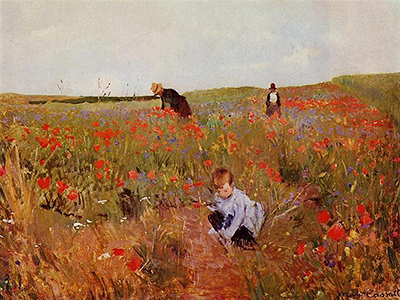Red Poppies is a delightful piece from approximately 1874-1880 which can now be found at the Philadelphia Museum of Art, Philadelphia, PA, US. Interestingly, they have attributed the painting to Victor Gabriel Gilbert, having originally believed it to be from the hand of Mary Cassatt.
The artwork itself is beautiful, featuring some delicate touches of red paint which form the iconic red poppies which cover much of this composition. We find a small child playing in the foreground, whilst two adults behind are busy at work. There is also Cassatt's signature in the bottom right corner of the painting, which adds to the feeling that this could still be from her own career. It arrived when she was fairly early on in her career and so perhaps documentation of her work was not particularly comprehensive at this stage, making mis-attributions more likely to occur. The style and content of Red Poppies is undeniably Impressionist, and one can suggest France as the location of this working field without any real study of the artwork. Many of the other members of this group had also produced similar paintings within their own careers, providing an interesting comparison between how each one would put together such a scene. Monet's Blooming Poppy Field (Wild Poppies, near Argenteuil) from 1873 is the most famous example, and may well have inspired the piece in front of us here.
If you compare the two paintings, it is almost as if Cassatt has taken the Monet work, rotated it horizontally, and then implemented her our preferred method of portraying young children, albeit from a much further distance away than she would normally do. The small openings between each marked field, where the workers would no doubt have walked, helps to provide a feeling of perspective and shadowing, as these angles head off into the distance. The poppies themselves were also ideal in providing some natural colour, with the bright reds working beautifully against the greens of the foliage. The young child found in this artwork wears a light blue top which helps them to contrast against the background and therefore become easier to see. It is likely that the figures are relatives of the child, and allowing them to play whilst they get on with working hard in the fields.
The Philadelphia Museum of Art, Philadelphia, PA, US has an impressive selection of art from a variety of periods and nations, but the Impressionist era is particularly well served here. For example, you will find the likes of Renoir, Monet, Manet, Degas and Cézanne and well represented here and it provides locals, plus visitors from further afield, with an excellent opportunity to browse through some of the finest European artworks from the 19th century and also to get an idea about how their creations would then inspire a large number of American artists to work in a similar fashion in the years that followed. Cassatt herself was strongly connected to the career of Degas, and so his work should also interest you, and they both worked within pastels for an extended period, helping this medium to be taken more seriously by academics.




